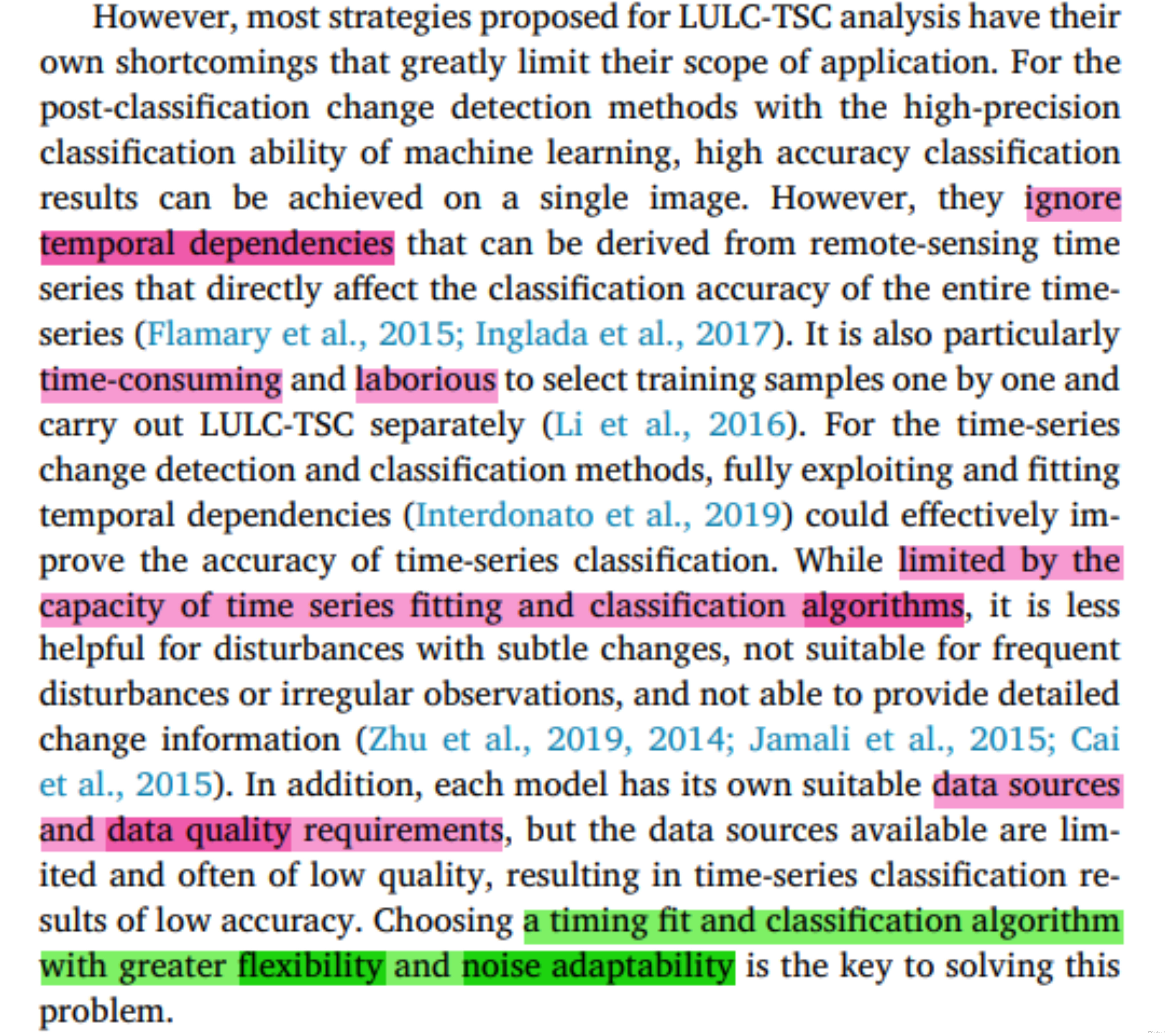
目录
1. Post-classification change detection methods
2. Time-series change detection and classification methods
Prophet and DTW based LULC-TSCCD
1. Prophet-based change-point detection in a long time-series
1.1. Background knowledge of Prophet
1.2. Prophet-based change-point detection
2. DTW-based time-series classification
2.1. Background knowledge of DTW
2.2. DTW-based time-series classification
Introduction

2 种 LULC-TSC 分类算法。LULC-TSC 的应用及其意义。
LULC-TSC :Land-Use/Land-Cover Time-Series Classification,土地利用/覆盖 时序分类

现存算法的缺点。解决方案:具有更大灵活性和更好噪声适应性的时间拟合与分类算法。

Taylor, S.J., Letham, B., 2018. Forecasting at scale. Am. Stat. 72 (1), 37–45.
Pencue-Fierro, E.L., Solano-Correa, Y.T., Corrales-Mu noz, J.C., Figueroa-Casas, A., 2016. A semi-supervised hybrid approach for multitemporal multi-region multisensor landsat data classification. IEEE J. Select. Top. Appl. Earth Observ. Remote Sens. 9 (12), 5424–5435.
Zaidi, S.M., Abolghasem, A., Azizan, A.S., Ngien, S.K., Aanak Gisen, J.I., 2017. Landsat-5 time series analysis for land use/land cover change detection using NDVI and semi-supervised classification techniques. Polish J. Environ. Stud. 26 (6), 2833–2840.
Related work
LULC 分类的 2 种常见算法:
1. Post-classification change detection methods
分类后的变化检测,顾名思义,指:基于待观测范围内的所有数据进行单相分类,比较和分析每个时相之间的差异,从而获得最终的时间序列分类结果。

缺点:(1) 这种方法并未考虑 地表覆盖的时间独立性(temporal dependency)以及 每个时间点提取的特征有何不同。这显然与自然现象不符。(2) 这类算法通常是监督学习,需要大量的训练数据。对于较长的时间序列 LULC 分类问题,很难在时相获取完整且正确的特征。
文章说的有点绕,个人认为:单相分类割裂了连续时序的完整特征,直觉上不太合理。
2. Time-series change detection and classification methods
为每个像元构建一个相关联的时间序列;分析并拟合特征在时间维度上的变化,估测并确认断点(breakpoint);分割时序,再对子时序进行分类;最后,得到时序分类结果。


Prophet and DTW based LULC-TSCCD

1. Prophet-based change-point detection in a long time-series
1.1. Background knowledge of Prophet
Prophet 是一种模块化回归模型(modular regression model),其参数易于理解,可以利用专业知识进行调节。
![]()
该算法将时间序列拆解成三个部分:trend、seasonality、holiday。上式中,g(t) 是 trend 函数,描述了时间序列中的非周期性变化。s(t) 表示 周期性变化,比如 每周或每年的 seasonality。h(t) 表示 holidays 的影响,holiday 指潜在的不规则事件。![]() 是误差项,代表了模式无法适应的一些特殊变化,一般认为是正态分布的。
是误差项,代表了模式无法适应的一些特殊变化,一般认为是正态分布的。



1.2. Prophet-based change-point detection
Change-points 指:时序从增长到减少 或者 从增长很快到增长很慢 的那些临界点。检测临界点的目标是寻找地物类型改变的时间段。主要步骤如下:




2. DTW-based time-series classification
2.1. Background knowledge of DTW



2.2. DTW-based time-series classification


Evaluation and experiments
1. Change detection performance evaluation
1.1. Change detection using TSCCD
1.2. Comparative experiments
(1) BFAST
(2) LandTrendr
(3) CCDC
1.3. Discussion
2. LULC-TSC experiment and analysis
2.1. Study area and experimental data
2.2. Experimental data preprocessing
2.3. Change-point detection and confirmation
2.4. DTW-based LULC classification
2.5. Analysis and discussion
3. Discussion
Conclusions
Appendix
Appendix A. Remote sensing image of Wuhan
Appendix B. The example change-point curves
Appendix C. Training samples for LULC-TSCCD



























 被折叠的 条评论
为什么被折叠?
被折叠的 条评论
为什么被折叠?








